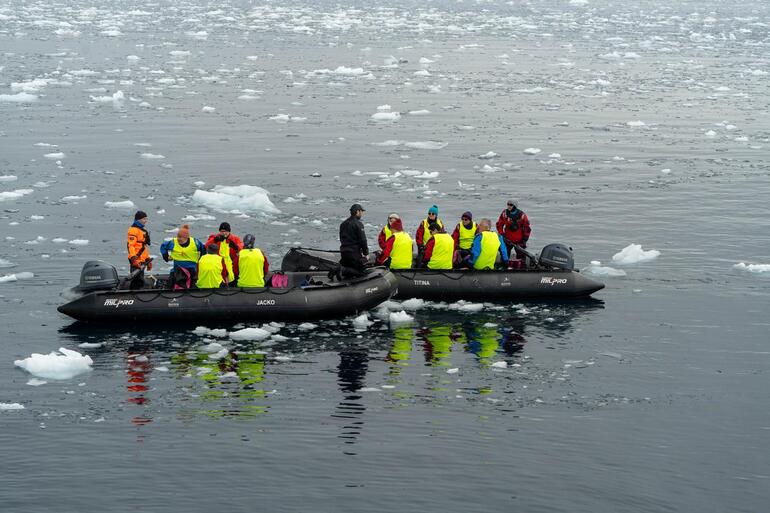Zodiacs in Antarctica
The Small Boats That Open a Vast Continent
Without Zodiacs in Antarctica, you could not easily set foot on the continent. These compact, inflatable vessels connect your expedition ship to the frozen coastline. As a result, they make it possible to step onto beaches crowded with penguins or to drift quietly beside sculpted icebergs.
Every day of your voyage, you will see Zodiacs being prepared and lowered into the water- the start of almost every Antarctic adventure. Although they may look simple, each one represents a piece of finely tuned engineering designed to survive and perform in one of the most unforgiving environments on Earth.
The Design That Made Polar Travel Possible
A Zodiac is not just an inflatable dinghy. It is a rigid-hulled inflatable boat, built from reinforced Hypalon or similar material that stays flexible in freezing temperatures. Because of this, it performs reliably even under stress from ice and waves. Multiple air chambers ensure that even if one is punctured, the vessel remains afloat.

Most Zodiacs in Antarctic measure 5-6 metres in length and carry around a dozen passengers plus a driver. The wide, buoyant tubes serve as both seats and stabilisers, giving the vessel its characteristic steadiness. Outboard motors of 40-60 horsepower provide enough thrust to handle
strong currents and navigate through brash ice.
Consequently, Zodiacs in Antarctica can nose onto rocky beaches or glide between icebergs with minimal environmental impact, accessing areas unreachable by larger vessels.
From Exploration to Expedition Tourism
The history of Zodiacs in Antarctica dates to the 1950s, when French explorer Paul-Émile Victor first employed them in polar fieldwork. Since then, they have proved lighter, safer, and more adaptable than the wooden or metal boats used previously.
Over time, expedition ships adopted Zodiacs for passenger landings and exploration. Their stability and reliability made them indispensable for both science and travel. Today, they are the essential link between ship and shore, forming the foundation of every Antarctic landing and small-group excursion.
For expedition staff, Zodiacs are trusted working tools- simple yet highly dependable. For guests, they provide the opportunity to experience Antarctica directly, feeling the sea spray and hearing the crackle of nearby ice.
Key Features That Make Zodiac Boats Ideal for Antarctica
Zodiacs in Antarctica are engineered for reliability, manoeuvrability, and safety in polar environments. In particular, their design enables expedition teams to land passengers on uncharted beaches and navigate among ice with confidence.
Each vessel combines simple handling with robust construction. The following core features define their performance in Antarctic operations:
• Four independent air chambers: Each chamber maintains buoyancy even if another is punctured, ensuring essential redundancy in icy waters.
• Tiller steering: A direct, hand-operated steering system gives the driver precise control when manoeuvring around ice or during close-quarters landings.
• Liftable tiller arm: Allows the outboard motor to be raised in shallow water or during beach landings, reducing the risk of propeller or rudder damage.
• Shallow draft: Enables Zodiacs to approach beaches and operate safely in confined bays or among floating ice where larger boats cannot reach.
• Reinforced, cold-resistant hull: Constructed from Hypalon or equivalent material that stays flexible in freezing temperatures and resists abrasion from ice and rock.
• Lightweight, rigid design: Combines stability with portability, allowing smooth handling in rough seas and efficient recovery to the ship.
Altogether, these characteristics make Zodiacs in Antarctica uniquely suited to expedition cruising. They balance strength and responsiveness, enabling safe and agile operation across the world’s most demanding marine environment.
Typical Specifications: Zodiac Mk V HD (Polar Configuration)
| Specification | Detail |
|---|---|
| Length overall | 5.85 m (19 ft 2 in) |
| Beam (width) | 2.54 m (8 ft 4 in) |
| Weight (unladen) | Approximately 470 kg |
| Passenger capacity | 10–12 plus driver |
| Air chambers | 4 independent tubes |
| Hull type | Rigid aluminium deck with inflatable collar |
| Draft | Shallow (≤ 0.30 m / 1 ft) |
| Engine power | 40–60 hp outboard motor |
| Top speed (light load) | Around 25 knots |
| Construction material | Hypalon or equivalent cold-resistant fabric |
| Steering | Manual tiller with liftable arm |
| Operating temperature range | –20 °C to +40 °C |
How Zodiacs Are Used on Expedition Cruises
Each expedition vessel carries its own fleet of Zodiacs, launched by crane or davit from the upper decks. Before each excursion, crew members check fuel, safety equipment, and radios. You will board from a low platform known as the marina deck, assisted by staff who stabilise the boat.
Once seated along the inflated sides, you will face inward as the driver- usually an experienced guide, steers from the stern. Because the boats are small, they can access landing sites, ice formations, and wildlife colonies beyond the reach of any larger ship.
Some outings involve shore landings, where you disembark onto beaches or ice shelves to explore. Others remain on the water, providing close encounters with icebergs, whales, and seals. In both cases, the experience depends entirely on the performance and reliability of the Zodiac.
Safety and Seamanship in Polar Waters
Zodiac operations in Antarctica are governed by strict safety protocols. All drivers receive specialised polar training covering navigation, cold-water safety, and emergency procedures.
Each boat carries lifejackets for every passenger, as well as an anchor, first-aid kit, pump, repair kit, and flares. Before your first outing, you will attend a briefing covering correct boarding techniques and safe posture on board. Always keep one hand free, follow crew instructions, and remain seated during travel.
Even so, weather conditions can change rapidly. Expedition leaders constantly monitor wind, visibility, and sea state, and they cancel operations immediately if safety is compromised.
How Zodiacs Handle Ice, Wind, and Waves
Zodiacs in Antarctica are built for flexibility and endurance. Their inflated collars absorb impact with floating ice, while the deep-V hull shape allows smooth progress through waves.
In light ice, drivers move slowly, using the bow to nudge smaller floes aside. When winds strengthen, several Zodiacs travel together for visibility and mutual assistance. Passengers should expect spray, cold air, and occasional jolts, but the ride remains secure and exhilarating.
Ultimately, the skill of the drivers and the reliability of the boats combine to make each journey feel adventurous but controlled- a balance that defines safe polar exploration.
The Guest’s Perspective: Practical Advice and Small Comforts
Dress and Equipment
Layered clothing is essential. Therefore, wear a thermal base layer, insulating mid-layer, and waterproof outer shell. Operators usually supply rubber boots, but you should bring gloves, hats, and a neck gaiter or balaclava. A waterproof bag keeps cameras, binoculars, and spare batteries safe from spray.
During the Ride
Zodiacs can move quickly, so keep your balance and secure all gear. Engine noise and wind make conversation difficult, yet when idling to view marine life, the sound is much quieter. Those moments- drifting beside a seal or under a blue-lit iceberg- are among the most vivid of any Antarctic voyage.
Environmental Awareness
All Zodiac activity follows the IAATO code of conduct. Passengers must maintain distance from wildlife, avoid sudden movement, and never touch or feed animals. By doing so, you help preserve the Antarctic wilderness for future visitors and research.
Maintenance and Care at Sea
After each excursion, crew rinse the Zodiacs with fresh water to remove salt and ice, then inspect valves, seams, and fuel lines. Engines are warmed and tested before storage. Boats are hoisted aboard with hydraulic cranes when not in use, ensuring they remain secure during rough weather.
In this way, the longevity and reliability of Zodiacs in Antarctica depend on daily attention. Regular maintenance allows them to withstand months of heavy use in some of the world’s harshest conditions.
Small Boats, Great Journeys
Zodiacs in Antarctica make exploration possible. They are the link between ship and shore, between travellers and the untouched continent itself. Their simplicity conceals remarkable design- strong, light, and endlessly reliable.
Ultimately, when you step into a Zodiac, you experience Antarctica at sea level: close to the ice, immersed in sound and cold air, surrounded by wildlife. These small boats have transformed access to the polar world, turning what was once the domain of explorers into a reachable, unforgettable experience. Just remember to tip the driver ;-).
